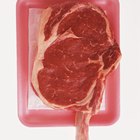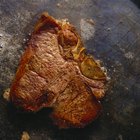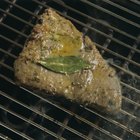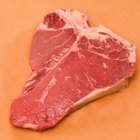Superanry/iStock/GettyImages
If you're standing in the open refrigerator door, stomach growling, wondering what to make for dinner, faced only with one real option -- steak with a sell-by date of yesterday -- take heart. Nothing terrible is going to happen to you if you cook and eat it. At least, not just because its sell-by date passed by one day.
It's "Sell-By," Not "Eat-By"
The sell-by date is very much what it sounds like: the last day the steak's producer advises retailers offer it to consumers. Of course, they can't assume you'll eat it the day you purchase it. Rather, a sell-by date assumes consumers will eat or freeze the product within a reasonable time after buying it. For beef, that's three to five days, as the USDA advises. It's therefore perfectly safe to cook steak one day past the sell-by date, or even a few days after it.
"Use-By" Must Mean "Eat-By," Right?
Sometimes, steak and other food has a use-by, best-by or best-if-used-by date, rather than a sell-by date. These labels aren't as incontrovertible as they sound. They aren't expiration dates. They indicate the manufacturer's estimated end of the food's peak quality window. In other words, food doesn't have to be thrown out on the indicated day. It doesn't instantaneously go from good to bad because of some numbers on the packaging. Assuming there's no perceptible evidence to the contrary, steak and other food may be consumed after these dates, they just may not be at peak quality anymore.
It's All About the Handling
Far more important than any date on your steak's packaging is how you handle it. If properly handled by the manufacturer, the store, you and all points in transit, steak should stay safe for about five days after purchase. Steak should not be between 40 degrees Fahrenheit and 140 F for a significant amount of time, as this is the "danger zone" in which bacteria reproduces rapidly. Don't leave steak out at room temperature longer than two hours, and if it's outside and hotter than 90 F, don't leave it out longer than one hour. Make sure your refrigerator is set below 40 F. If you aren't cooking the steak within five days, freeze it in airtight packaging and it stays good indefinitely, though the quality declines after six months to one year.
When Not to Eat Steak
If steak isn't handled properly somewhere along the way before it comes to its final resting place on your plate, it can go bad, even before a sell-by, best-by or use-by date on the label. When left in the "danger zone" too long or contaminated by particularly nasty microorganisms, meat spoils quickly. Fortunately, it's usually fairly easy to identify spoiled beef. It has an off or even foul odor and the meat becomes tacky or slimy. After about five days of refrigeration, beef begins browning; a little browning in and of itself doesn't indicate spoiled beef, but the meat is on its way there and should be eaten promptly before browning becomes more widespread.
Related Articles

What Are the Dangers of Out of Date ...

What Happens if You Cook Steak a Day ...

How to Know When Pork Roast Goes Bad

How to Keep Lunch Meat

How to Know if Marinated Steak Is Bad

Tuna Steaks Nutrition

How to Defrost a Steak and Keep It ...

How to Know If Roast Beef Looks Good or ...

Can You Eat a Hamburger That Is Pink ...

Can You Cook Meat Gone Bad?

Can You Cook Pork Two Days After ...
How Long Should I Keep Steaks ...

How Can I Tell If Lunch Meat Has Gone ...

Is it Safe to Cook Chicken 2 Days After ...

Indications of Refrigerated Cooked Meat ...
What Are the Dangers of Cooked Meat ...

How Long Does It Take for Ground Beef ...

Can I Cut Freezer-Burn Off a Tuna Steak ...

How Many Calories Are in a McDonald's ...

How to Broil Strip Steak
References
Writer Bio
Eric Mohrman is a food and drink, travel, and lifestyle writer living in Orlando, Florida. He has professional experience to complement his love of cooking and eating, having worked for 10 years both front- and back-of-house in casual and fine dining restaurants. He has written print and web pieces on food and drink topics for Visit Florida, Orlando Style Magazine, CrushBrew Magazine, Agent Magazine, Dollar Stretcher Magazine, The 863 Magazine and other publications.